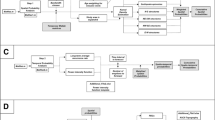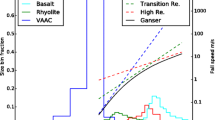Abstract
Volcanic ash is the most widespread of all volcanic hazards and has the potential to affect hundreds of thousands, or even millions, of people in the densely populated islands of Indonesia. There is limited information available for this region on the hazard posed by volcanic ash, particularly from volcanoes that have not erupted in recent times. There is a need for computational models capable of accurately predicting volcanic ash dispersal at ground level when coupled with field observations of historical or ongoing eruptive activity. To maximise the effectiveness of such models, they should be readily accessible, easy to use and well tested. Geoscience Australia in collaboration with the Australia-Indonesia Facility for Disaster Reduction and the Indonesian Centre for Volcanology and Geohazard Mitigation has collaboratively adapted an existing open-source volcanic ash dispersion model for use in Indonesia. The core model is the widely used, open-source volcanic ash dispersion model FALL3D. A Python wrapper (name here python-FALL3D) has been developed, which modifies the modelling procedure of FALL3D in order to simplify its use for those with little or no background in computational modelling. The modified procedure does not alter the core functionality of FALL3D, but simplifies the modelling procedure by streamlining the installation process, automating both the pre-processing of input meteorological datasets and configuring and executing each utility program in a single-step process. An application example was presented using python-FALL3D for an active volcano in West Java, Indonesia. The example showed that communities located on the western side of Gunung Gede are always susceptible to volcanic ash ground loading regardless of the seasonal variations in wind conditions, whereas communities on the eastern side of Gunung Gede have a marked increase in susceptibility to ground loading during rainy season conditions when prevailing winds include a strong easterly component.







Similar content being viewed by others
References
Barberi F, Macedonio G, Pareshci MT, Santacroce R (1990) Mapping tephra fallout risk: an example from Vesuvius, Italy. Nature 344:142–144
Barsotti S, Neri A, Scire JS (2008) The VOL-CALPUFF model for atmospheric ash dispersal: 1. Approach and physical formulation. J Geophys Res-Solid Earth 113(B03208). doi:10.1029/2006JB004623
Blong R (1984) Volcanic hazards. A sourcebook on the effects of eruptions. Academic Press, Inc, Orlando
Blong R (2003) Building damage in Rabaul, Papua New Guinea, 1994. Bull Volcanol 65(1):43–54
Bonadonna C (2006) Probabilistic modelling of tephra dispersion. In: Mader H, Coles SG, Connor CB, Connor LJ (eds) Statistics in volcanology. Geological Society of London, London, pp 243–259
Bonadonna C, Costa A (2012) Modelling tephra sedimentation from volcanic plumes. In: Fagents SA, Gregg TKP, Lopes RMC (eds) Modelling volcanic process: the physics and mathematics of volcanism. Cambridge University Press, Cambridge
Bursik M (2001) Effect of wind on the rise height of volcanic plumes. Geophys Res Lett 18:3621–3624
Corradini S, Merucci L, Folch A (2011) Volcanic ash cloud properties: comparison between MODIS satellite retrievals and FALL3D transport model. IEEE Geosci Remote Sens Lett 8(2):248–252
Costa A, Macedonio G, Folch A (2006) A three-dimensional Eulerian model for transport and deposition of volcanic ashes. Earth Planet Sci Lett 241:634–647
Costa A, Dell’Erba F, Di Vito MA, Isaia R, Macedonio G, Orsi G, Pfeiffer T (2009) Tephra fallout hazard assessment at Campi Flegrei caldera (Italy). Bull Volcanol 71:259–273
Durant A, Bonadonna C, Horwell CJ (2010) Atmopsheric and environmental impact of volcanic particulates. Elements 6(4):235–240
Folch A, Felpeto A (2005) A coupled model for dispersal of tephra during sustained explosive eruptions. J Volcanol Geoth Res 145(3–4):337–349
Folch A, Sulpizio R (2010) Evaluating long-range volcanic ash hazard using supercomputing facilities: application to Somma-Vesuvius (Itay), and consequences for civil aviation over the Central Mediterranean Area. Bull Volcanol 72:1039–1059
Folch A, Cavazzoni C, Costa A, Macedonio G (2008a) An automatic procedure to forecast tephra fallout. J Volcanol Geoth Res 177:767–777
Folch A, Jorba O, Viramonte J (2008b) Volcanic ash forecast—application to the May 2008 Chaiten eruption. Nat Hazards Earth Syst Sci 8:927–940
Folch A, Costa A, Macedonio G (2009) FALL3D: a computational model for transport and deposition of volcanic ash. Comput Geosci 35:1334–1342
Folch A, Costa A, Basart S (2012) Validation of the FALL3D ash dispersion model using obsrvations of the 2010 Eyjafjallajokull volcanic ash clouds. Atmos Environ 48:165–183
Handley KH, Macpherson CG, Davidson JP (2010) Geochemical and Sr-O isotopic contraints on magmatic differentiation at Gede Volcanic Complex, West Java, Indonesia. Contrb Mineral Petrol 159:885–908
Heiken G, Casadevall T, Newhall CG (1992) The 1st international symposium on volcanic ash and aviation safety. Bull Volcanol 54(3):250–251
Horwell CJ, Baxter PJ (2006) The respiratory health hazards of volcanic ash: a review for volcanic risk mitigation. Bull Volcanol 69(1):1–24
Hurst AW (1994) ASHFALL—a computer program for estimating volcanic ash fallout (Report and User Guide). Institute of Geological & Nuclear Sciences science report 94(23)
Hurst AW, Turner R (1999) Performance of the program ASHFALL for forecasting ashfall during the 1995 and 1996 eruptions of Ruapehu volcano. NZ J Geol Geophys 42:615–622
Macedonio G, Costa A, Longo A (2005) A computer model for volcanic ash fallout and assessment of subsquent hazard. Comput Geosci 31:837–845
Macedonio G, Costa A, Folch A (2008) Ash fallout scenarios at Vesuvius: numerical simulations and implications for hazard assessment. J Volcanol Geoth Res 178:366–377
Mastin LG, Guffanti M, Servranckx R, Webley P, Barsotti S, Dean K, Durant A, Ewert JW, Neri A, Rose WI, Schneider D, Siebert L, Stunder B, Swanson G, Tupper A, Volentik A, Waythomas CF (2009) A multidisciplinary effort to assign realistic source parameters to models of volcanic ash-cloud transport and dispersion during eruptions. J Volcanol Geoth Res 186(1–2):10–21
Rose WI, Durant A (2011) Fate of volcanic ash: aggregation and fallout. Geology 39(9):895–896
Searcy C, Dean K, Stringer W (1998) PUFF: a high-resolution volcanic ash tracking model. J Volcanol Geoth Res 80(1–2):1–16
Selva J, Costa A, Sandri L, Marzocchi W (2010) BET VH: exploring the influence of natrual uncertainties on long-term hazard from tephra fallout at Campi Flegrei (Italy). Bull Volcanol 72:713–733
Simpson A, Johnson RW, Cummins P (2011) Volcanic threat in developing countries of the Asia-Pacific region: probabilistic hazard assessment, population risks, and information gaps. Nat Hazards 57:151–165
Situmorang T, Hadisantono RD (1992) Geological map of Gede Volcano, Cianjur, West Java, Volcanic Survey of Indonesia
Sparks RSJ, Bursik M, Carey S, Gilbert JS, Graze LS, Sigurdsson H, Woods AW (1997) Volcanic plumes. Wiley and Sons, Chichester
Spence RJS, Kelman I, Baxter PJ, Zuccaro G, Petrazzuoli S (2005) Residential building and occupant vulnerability to tephra fall. Nat Hazards Earth Syst Sci 5(4):477–494
Suzuki T (1983) A theoretical model for dispersion of tephra. In: Shimozuru D, Yokoyama I (eds) Arc volcanism: physics and tectonics. Terra Scientific Publishing Company, Tokyo
Acknowledgments
This work was supported by the Indonesian Agency for Disaster Management (BNPB) and AusAID through the Australia-Indonesia Facility for Disaster Reduction (AIFDR).
Author information
Authors and Affiliations
Corresponding author
Rights and permissions
About this article
Cite this article
Bear-Crozier, A.N., Kartadinata, N., Heriwaseso, A. et al. Development of python-FALL3D: a modified procedure for modelling volcanic ash dispersal in the Asia-Pacific region. Nat Hazards 64, 821–838 (2012). https://doi.org/10.1007/s11069-012-0273-7
Received:
Accepted:
Published:
Issue Date:
DOI: https://doi.org/10.1007/s11069-012-0273-7




